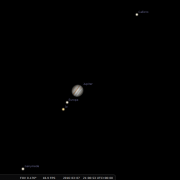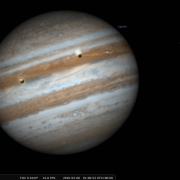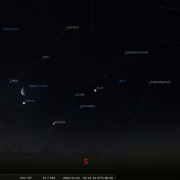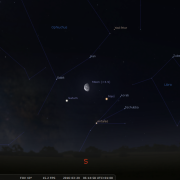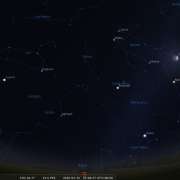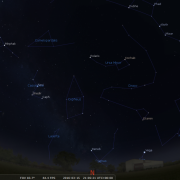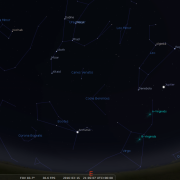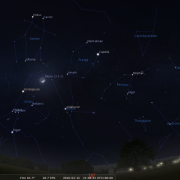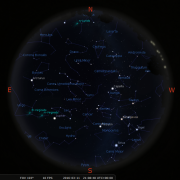In this month's Sky Notes:
Planetary Skylights
 Jupiter reaches opposition on the 7th when it will be visible from sunset to sunrise residing due south at local midnight. You should have no difficulty identifying Jupiter – it will be the brightest ‘star’ in the night sky. Viewed through a telescope, Jupiter is a fine spectacle, the belted disc and dance of the Galilean moons all make for fascinating observation. On opposition night itself all 4 moons will be visible; however by 01:00h on the 8th both Europa and Io will be transiting the disc, their shadows appearing as small black disks against Jupiter’s. The moon lies in the vicinity of Jupiter on the 21st.
Jupiter reaches opposition on the 7th when it will be visible from sunset to sunrise residing due south at local midnight. You should have no difficulty identifying Jupiter – it will be the brightest ‘star’ in the night sky. Viewed through a telescope, Jupiter is a fine spectacle, the belted disc and dance of the Galilean moons all make for fascinating observation. On opposition night itself all 4 moons will be visible; however by 01:00h on the 8th both Europa and Io will be transiting the disc, their shadows appearing as small black disks against Jupiter’s. The moon lies in the vicinity of Jupiter on the 21st.


 Mars and Saturn reside in the dawn sky – located to the south around 05:00h. Mars has an obvious orange hue, whereas Saturn, which resides to the left of Mars, will have a pearly white lustre. Both should be quite conspicuous. With Mars not reaching opposition until late May its disc is still rather small when viewed through a modest telescope. As the Earth draws closer matters will improve with general surface detail on Mars becoming more apparent. The Moon lies nearby on the 29th.
Mars and Saturn reside in the dawn sky – located to the south around 05:00h. Mars has an obvious orange hue, whereas Saturn, which resides to the left of Mars, will have a pearly white lustre. Both should be quite conspicuous. With Mars not reaching opposition until late May its disc is still rather small when viewed through a modest telescope. As the Earth draws closer matters will improve with general surface detail on Mars becoming more apparent. The Moon lies nearby on the 29th.
Saturn is a wonderful early morning observing tonic, as long as you have a telescope. As commented on last month, if you don’t have sufficient time to view on a morning outside;- a set up scope inside may be the solution. Whichever route you take, Saturn is a glorious sight with the open orientation of the rings. Look for its major moon Titan close by –visible as a speck of light orbiting around Saturn twice a month. Our moon lies in the vicinity of Saturn on the 30th.
Mercury and Venus have both departed from the dawn sky and will remain out of sight for the whole month.
Spring Equinox
 The date of the Vernal Equinox and officially the start spring in the northern hemisphere falls on March 20th this year. This is when the Sun's path - the ecliptic, first crosses the celestial equator on its apparent journey northwards into the sky.
The date of the Vernal Equinox and officially the start spring in the northern hemisphere falls on March 20th this year. This is when the Sun's path - the ecliptic, first crosses the celestial equator on its apparent journey northwards into the sky.
The orientation of the Earth at the spring or autumnal equinox is such that neither of the poles are inclined towards the Sun and all locations experience equal hours of daylight and darkness - hence the term equinox.
 The Vernal Equinox is also known as the 'First point of Aries', as the Sun used to stand before the constellation of the Ram when it first crossed the celestial equator. Although still called the 'first point of Aries', today its location now resides in Pisces, a consequence of the effect known as precession - the Earth's slow wobble over thousands of years.
The Vernal Equinox is also known as the 'First point of Aries', as the Sun used to stand before the constellation of the Ram when it first crossed the celestial equator. Although still called the 'first point of Aries', today its location now resides in Pisces, a consequence of the effect known as precession - the Earth's slow wobble over thousands of years.
Our ancestors noted that certain star patterns rose just before the Sun at specific times and were considered significant for this very reason. Subsequently they were able to build a picture of the apparent path of the Sun against these constellations.
The narrow path upon which occasionally the Sun and Moon would meet giving rise to an eclipse, became known as the Ecliptic. The broader belt along which the 'wandering stars' or planets travelled was known as the Zodiac, so called because all 12 constellations located on it were associated with living creatures.
Zodiac literally means 'Band of Animals'. Libra used to be considered being part of Scopius, the claws to be precise. Ophiuchus, the serpent bearer immediately following Scorpius was instead regarded as a zodiac group. Ever since the stars of Libra were elevated in status, Ophiuchus, being surplus to requirements, was ditched, much to the relief of astrologers. If you find it difficult to remember the order of the zodiac constellations, then the following rhyme may be of use.
The Ram, the Bull, the Heavenly twins,
and next the Crab the Lion shines,
the Virgin, and the Scales.
Scorpion, Archer and Sea goat,
The man who pours the water out
and Fish with glittering tails.
Slow Season for Meteor Showers

No major showers. However at the very end of March you may spot a few Viginids, which are very slow moving and have long paths. As usual early morning hours are more favourable
March 2016 Sky Charts
Click each image to see a full-size Sky Chart:
|
Looking South
Mid March - 21:00h |
Looking North |
|
Looking East
Mid March - 21:00h |
Looking West
Mid March - 21:00h |
|
|
|
|
Overview
Mid March - 21:00h |
|
Additional Image Credits:
- Planets and Comets where not otherwise mentioned: NASA
- Sky Charts: Stellarium Software
- Log in to post comments

